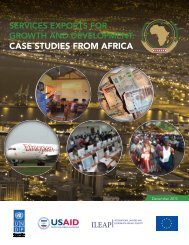BUDGET
budget
budget
Create successful ePaper yourself
Turn your PDF publications into a flip-book with our unique Google optimized e-Paper software.
36 MEETING OUR GREATEST CHALLENGES: OPPORTUNITY FOR ALL<br />
proposed in the next Higher Education Act reauthorization,<br />
would support teacher and principal<br />
preparation programs and nonprofits partnering<br />
with school districts to create or expand<br />
high-quality pathways into teaching and school<br />
leadership, particularly in high-need subjects<br />
such as STEM. A new program, Teach to Lead,<br />
would fund teacher-led projects to improve the<br />
quality of education, drawing on the knowledge<br />
and passion of teachers to identify, implement,<br />
and expand effective practices. Furthermore,<br />
the Budget includes RESPECT: Best Job in the<br />
World, a $1 billion mandatory initiative that<br />
would support a nationwide effort to attract and<br />
retain effective teachers in high-need schools by<br />
increasing compensation and paths for advancement,<br />
implementing teacher-led development<br />
opportunities to improve instruction, and creating<br />
working conditions and school climates<br />
conducive to student success. This proposal is<br />
a key strategy in the Department’s efforts to<br />
ensure all students’ equitable access to effective<br />
teachers.<br />
Promoting College Affordability<br />
and Completion<br />
Today’s economy increasingly demands highly-educated<br />
workers. Higher education is one of<br />
the clearest pathways into the middle class, and<br />
decades of research has shown large returns to<br />
higher education in terms of labor market earnings,<br />
health, and well-being. In fact, research<br />
shows that the typical college graduate earns<br />
twice as much over his or her lifetime as the typical<br />
high school graduate. Further, over the next<br />
decade, jobs requiring education beyond high<br />
school will grow more rapidly than jobs that do<br />
not, with more than half of the 30 fastest-growing<br />
occupations requiring postsecondary education.<br />
From the start of the Administration, the<br />
President has focused on making college more<br />
accessible and affordable for all Americans, with<br />
the goal of making the United States the leader<br />
once again in college completion, as it was a<br />
generation ago. The Administration ended the<br />
inefficient guaranteed student loan program and<br />
reinvested the savings into making college more<br />
affordable, including strengthening and expanding<br />
the Pell Grant program, the cornerstone of<br />
opportunity for low- and moderate-income students.<br />
The Pell Grant program is now supporting<br />
scholarships for significantly more students to<br />
attend college than when the President took<br />
office.<br />
In December, the American Opportunity Tax<br />
Credit (AOTC)—first enacted in the Recovery<br />
Act—was made permanent. The AOTC expands<br />
the level of support for college by providing a<br />
maximum credit of $2,500 per year for the first<br />
four years of college—up to $10,000 per student<br />
to cover tuition and educational expenses. The<br />
AOTC is partially refundable, so it provides<br />
critical college tuition help to low- and moderateincome<br />
families. The AOTC will cut taxes by over<br />
$1,000, on average, for nearly 10 million families<br />
in 2016.<br />
Overall, since 2009, these investments in Pell<br />
Grants and tax credits have doubled, increasing<br />
the access and affordability of college for<br />
students.<br />
The Administration has also made historic<br />
investments in the creation and expansion<br />
of community college programs aligned to<br />
in-demand jobs in high-growth industries<br />
from health care to information technology<br />
(IT). From 2011 through 2014, some $2 billion<br />
in funding reached more than half of all<br />
community colleges across the United States,<br />
enrolling over 176,000 students to date.<br />
Employers have donated thousands of dollars<br />
in equipment, scholarships, tuition, and more<br />
to support these programs.<br />
The Administration also has made it easier<br />
and faster for students to apply for Pell Grants<br />
and other financial aid. Since taking office, the<br />
Department of Education has significantly simplified<br />
the Free Application for Federal Student<br />
Aid, known as the FAFSA. The Administration<br />
has reduced the time required to complete the<br />
FAFSA by two-thirds, to about 20 minutes, by revamping<br />
the online form for all families so they<br />
can skip questions that are not relevant to them




